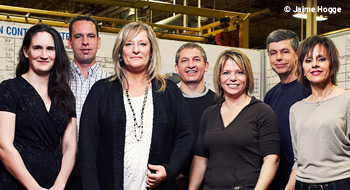

TRW Automotive, headquartered in Livonia, Mich., has more than 60,000 employees and contractors working at 185 facilities worldwide—five of which are in Canada.
In 2009, in partnership with Sun Life Financial Canada, the US$14.4-billion manufacturer of automotive safety systems began offering online health risk assessments (HRAs) and biometric screenings north of the 49th to its roughly 500 salaried and non-union hourly employees at the Midland, St. Catharines, Tillsonburg, Windsor and Woodstock, Ont., plants.
“If [employees] take both of those components, they’re eligible to receive a $150 incentive that we put in a healthcare spending account [HCSA],” says Carrie Montgomery, benefits administrator with TRW in Livonia. “If they have a spouse enrolled in the plan, the spouse can take the online HRA and earn an additional $100 [to go toward the HCSA].” (The biometric screening is held on-site during work hours and therefore is not open to spouses.)
Montgomery explains that TRW designed its wellness initiatives to be proactive rather than reactive, stemming from a corporate mission to help employees maintain their health in order to avoid future medical issues.
“The overall goal is to help employees and their families reduce medical risks, improve overall health and decrease healthcare spending.”
TRW has provided incentives for wellness initiatives to its U.S. operations since 2006. But in the last few years, the program has become much more robust, says Shelly Iacobelli, director of pension and benefits with TRW in Livonia, adding that the online HRAs and screenings are the only similar elements offered in both the company’s U.S. and Canadian locations. (The U.S. program also offers tobacco cessation programs, online health education courses and opportunities for employees to engage with a nurse to manage health conditions or participate in lifestyle behavioural change programs.)
Each year, during the company’s annual enrollment period, materials about the upcoming wellness programs for the year are sent to employees. Once the formal campaign kicks off in the spring, the company rolls out a targeted communications plan, including posters and pay stuffers.
“And there is an initial launch letter that comes from the plant managers at each of [the five] plants, then follow-up letters sent by HR management—just to remind employees about the programs and the timelines,” says Montgomery.
HR managers at Canadian locations also receive a PowerPoint presentation so they can hold meetings with employees to walk them through the offerings. And while the campaign is in full drive, if attendance is low at the biometric screenings (employees register for the clinics in advance), HR sends daily reminder emails to employees noting that the clinics are in progress and that walk-ins are welcome.
The overall goal is to help employees and their families reduce medical risks, improve overall health and decrease healthcare spending.
At TRW’s Tillsonburg site, closed-circuit TVs in the lunchroom offer an added communications piece by allowing management to air messages about the program throughout the workday.
“All the information that is sent to me, we put out to all the employees—on what is happening, how to get involved, how they go online and set up their own appointments,” explains Joan Martin, HR administrator for the Tillsonburg plant.
Of course, no matter how much information a company presents on an initiative, there will always be employees who still have questions and concerns.
“Probably the biggest challenge we have is people think that we’re going to use their information against them from an employment perspective,” says Iacobelli. “So we continue to reiterate to employees that the information we receive back is in aggregate.”
In the future, however, the positive feedback that TRW has received from participants will help to “sell” the program to other employees, she adds.
Another challenge is cost. “We were going to offer wellness modules that [employees] could take online and coaching programs, but then the market fell out in ’09,” eliminating funding for extra wellness initiatives, explains Iacobelli.
At the end of the wellness program, participants complete an evaluation survey. Of the Canadian employees who provided feedback for the 2011 program, 89% indicated that the biometric screenings helped them learn about their health, and 80% said they wouldn’t have known their health scores if they hadn’t attended. Almost half (49%) revealed that they would not have been screened by a family physician if TRW had not offered the program. The program is prompting participating employees to alter certain behaviours, too: almost three-quarters (72%) said they’d be making a health change.
General comments have been just as positive. Examples from past participants include I will use this to make changes and Worth the time.
“We’re starting to see people value this not only from getting the [HCSA] incentive to help offset their plan costs but also for their own health benefits,” notes Iacobelli.
“I think it was very positive,” says Martin about the impact of TRW’s 2011 program on Tillsonburg participants. “People are quite interested in getting that extra [HCSA] money and getting healthy.”
In fact, she says employees are already asking if the program will be offered again this year. “We’ve already had an email go out to set dates,” she laughs.
Brooke Smith is managing editor of Benefits Canada. brooke.smith@rci.rogers.com
Get a PDF of this article.



